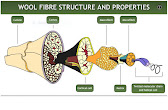Cuticle
On the outside of the wool fibre is a protective layer of scales called cuticle cells. They overlap like tiles on a roof. The exposed edges of the cells face away from the root end so there’s more friction when you rub the fibre in one direction than the other.The scales have a waxy coating chemically bound to the surface. This stops water penetrating the fibre but allows absorption of water vapour. This makes wool water-repellent and resistant to water-based stains.
Cortex
The cortex – the internal cells - make up 90% of the fibre. There are 2 main types of cortical cells – ortho-cortical and para-cortical. Each has a different chemical composition. In finer fibres, these two types of cells form in two distinct halves. The cells expand differently when they absorb moisture, making the fibre bend - this creates the crimp in wool. In coarser fibres, the para-cortical and ortho-cortical cells form more randomly so there’s less crimp.Fibre crimp makes wool feel springy and provides insulation by trapping air.
Cortical cell
The cortical cells are surrounded and held together by a cell membrane complex, acting similarly to mortar holding bricks together in a wall.The cell membrane complex contains proteins and waxy lipids and runs through the whole fibre. The molecules in this region have fairly weak intermolecular bonds, which can break down when exposed to continued abrasion and strong chemicals.
The cell membrane complex allows easy uptake of dye molecules.


No comments:
Post a Comment